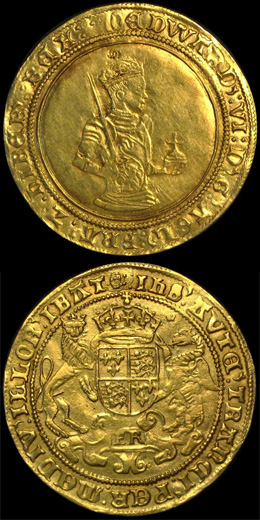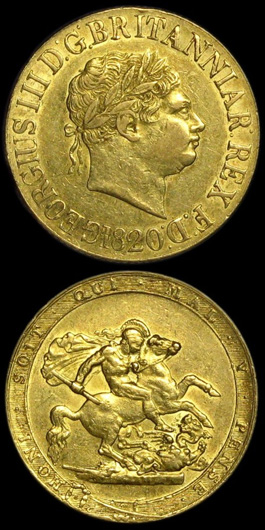English Gold Coins:
English Gold Coins (overview) | Gold Penny | Gold Florin | Gold Noble | Gold Ryal | Gold Laurel | Gold Unite | Triple Unite | Gold Crown | Gold Angel | Gold Guinea | Gold Coins Of The Black Prince | Five Guineas | Gold Sovereigns | Fine Sovereign | Double Sovereign | Two Pound Coin | Five Pound Coin | Gold Proof Coins | Elizabeth II Diamond Jubilee Gold Coins
Gold Sovereigns
Share this page:

Hammered Gold Sovereign of King Edward VI.
1551-1553 issue. Mint mark - Tun.
(S.2450, N.1927)
Image supplied by AMR Coins.
The Gold Sovereign is undoubtedly the most famous of all the British gold coins. Sovereigns were the first one pound coins - their price being set at 20 shillings; however this price, and the amount of gold contained in the coins, was to fluctuate many times throughout history.
Henry VII Gold Sovereigns
The first gold sovereign was an English hammered coin first struck in 1489, during the reign of King Henry VII of England (1485-1509). Lord Daubeney and Bartholomew Reed, joint masters and workers of the mint by Royal appointment, were given instructions to create a new gold coin at the "standard fineness" - 958 fine,also known as 23 carat; the standard for gold at the time. [3] The sovereign had an initial face value of twenty shillings - one pound - and was at first called the double-ryal, being based on the Dutch real d'or. [1] The coin acquired the name "sovereign" because it depicted the king in full portrait, seated upon his throne. [2] The new coin weighed 240 grains - exactly half a troy ounce and thus each coin contained 230 grains of pure gold. Gold sovereigns of Henry VII were all struck at the Tower of London and appear in four or five slight variations, including some mint mark variations.
Hammered Gold Sovereigns
Gold sovereigns were struck throughout the 16th century and kept the same face value of 20 shillings for most issues. However in the second coinage (1526-1544) of Henry VIII, the value of the sovereign was raised to 22 shillings, then 22 shillings and sixpence; in order to keep the value of the coin in line with fluctuating gold prices and prevent the coin being exported to Europe, where it would be worth more and possibly melted down.
In Henry VIII's third coinage, the value returned to 20 shillings but the sovereign was cleverly made smaller at 200 grains - a typical Henry VIII tactic! Henry VIII also introduced a half sovereign with his third coinage (1544-47), coins weighing either 100 or 96 grains. [2]
The sovereign was struck until 1604, using the hammering method although several similar twenty shilling gold pieces continued to be made under different names. Sovereigns were later re-introduced in 1817, and were milled using machinery; commencing after the Great Recoinage of 1816.
A pound had been an English currency denomination for hundreds of years, being based originally on a troy pound of silver by weight. However the gold sovereign of Henry VII was the first one pound coin ever made. It might be said that this was an attempt to "fix" the price ratio of silver to gold at 1:20 - however despite the rationality, at first glance, of these attempts, they ran up against innumerable challenges including debasement, clipping and black market trade in the coins with Europe.
At this time period, the precious metal content, weight and face value of coins changed countless times as monarchs attempted to solve financial problems by a variety of methods. This must have been a source of great confusion and the general public would have had to have been constantly on guard against inferior quality coin. In those days, getting paid was not as simple as counting the money. Getting paid or receiving coin for goods might have been either a good or bad deal, depending on the quality of the coin. Some monarchs were subtle, changing the purity or size of coin slightly. Others such as Henry VIII were bolder in their tactics. In some cases, the financial problems were caused directly by military spending, or by the extravagance of the monarch. However for centuries English coin, very often being of reliable and superior purity, was often exported for profit in a form of black market trade - exchanged for lower purity European coin, which was then laundered into circulation in England.
The issues were never fully solved and fluctuations in the prices of the metals meant that throughout the centuries people continued to seek to profit by exchanging their gold for silver or vice versa.
Hammered Double Sovereigns and Treble Sovereigns
A very small number of examples of hammered double and treble sovereigns from the 15th an 16th centuries exist. These coins are described here - double sovereign.
Fine Sovereigns
In the "third period" coinage, 1550-1553, Edward VI issued a 240-grain fine sovereign, valued at thirty shillings (Spink) or 24 shillings (Keynon). These coins are extremely rare and valuable nowadays, listed in catalogues as worth between £20,000 and £57,500.
The tradition of the 30 shilling, high purity 240 grain fine sovereign was continued by Mary (1553-1554) and then Elizabeth I. James I minted a 30 shilling coin in similar style, however this was called the Rose-Ryal. [2]
Gold Unite
The English sovereign was struck until 1604, in the reign of James I, when a coin was issued that is now called the unite. James then introduced the gold laurel in 1619, valued at twenty shillings - again, effectively a sovereign, but named due to its depiction of the King wearing a laurel wreath instead of a crown. The unite was continued by Charles I, who also issued a triple unite - the highest denomination hammered coin ever made in England. Charles I also issued a silver pound which was used to pay his soldiers during the civil war. [1]
Gold Broad
Cromwell issued a twenty shilling gold coin in 1656. This was called the broad. This coin featured a grained edge and reverse / obverse upside-down from each other. Also known in old times as the Laureat. These coins were called in 1732 together with other hammered gold coins; to be replaced by milled coinage. [4]
Gold Guinea
In 1663, Charles II issued gold guineas, which were at that time also valued at twenty shillings. The coins were unofficially named guineas because the gold used in them was imported from Guinea. Later the value of the guinea would be altered many times, eventually settling at twenty-one shillings after the last guineas were made. [5]
Milled Gold Sovereigns

George III Sovereign
Milled. Date: 1820
Image supplied by AMR Coins.
In 1816, new coin was minted, the old coin being called in. The new coins were machine-made to a higher standard of precision. Gone were the guinea denominations, and gold coins of five pounds, two pounds and one pound were made. The one pound coin was once again called the sovereign and the first of these were declared legal tender on July 1st 1817. [1] The coins were made at .9166 fine (22 carat), with a diameter of 22mm: The gold content being fixed at 113 grains (7.322 g, 0.2354 troy ounces). These dimensions and purity have remained the same for the gold sovereign until present times.
Gold sovereigns were made with almost every date until 1932, then again from 1957 to 1982 as bullion coins. Since 1816 the coin has always featured either a "shield and crown" or "St. George slaying the dragon" reverse design - apart from the year 1989, when a special 500-year anniversary sovereign design was used, giving the long suffering dragon a brief respite. The 500th anniversary coin featured a classic "monarch on the throne" obverse design with legend in eye-pleasing "Lombardic" lettering style. The reverse design features a Tudor rose, with shield and crown superimposed. Production of proof sovereigns for collectors were produced from then until 1999, and then bullion sovereigns have again been made since 2000. [6]
Rare Gold Sovereigns
Of particular rarity is 1819, which worth a small fortune in any condition and is unheard of in uncirculated condition. Any proof sovereign 1910 or earlier is very valuable (if uncirculated). Other particularly rare dates to look out for include 1828, and 1953 (of which around 10 are thought to exist). In other years, certain sovereigns are rare and valuable if particular mint marks appear (see a coin catalogue for full lists of rare sovereigns by mint mark.)
References:
[1] Coincraft's Standard Catalogue of English and UK coins
[2] Spink - Coins of England and the United Kingdom
[3] Keynon - The Gold Coins Of England, p.112
[4] Markham, 1739 - http://books.google.com/books?id=HYNZAAAAYAAJ&pg=PA83
[5] http://en.wikipedia.org/wiki/Guinea_(British_coin)
[6] http://en.wikipedia.org/wiki/Sovereign_(British_coin)




